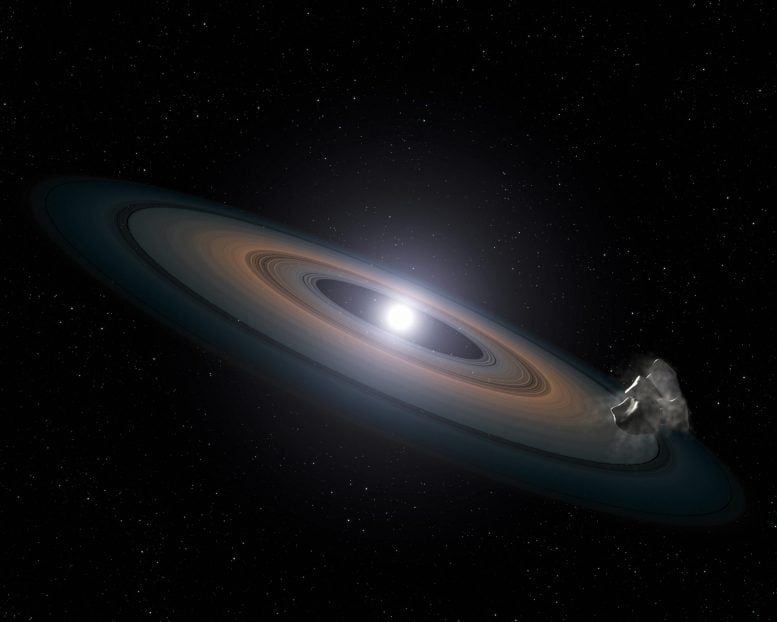
This illustration is an artist’s impression of the thin, rocky debris disc discovered around the two Hyades white dwarfs. Rocky asteroids are thought to have been perturbed by planets within the system and diverted inwards towards the star, where they broke up, circled into a debris ring, and were then dragged onto the star itself. Credit: NASA, ESA, STScI, and G. Bacon (STScI)
The Hubble Space Telescope has detected signs of Earth-like planets in debris whirling around two white dwarfs, finding silicon in the stars’ atmospheres and detecting low levels of carbon.
The NASA/ESA Hubble Space Telescope has found signs of Earth-like planets in an unlikely place: the atmospheres of a pair of burnt-out stars in a nearby star cluster. The white dwarf stars are being polluted by debris from asteroid-like objects falling onto them. This discovery suggests that rocky planet assembly is common in clusters, say researchers.
The stars, known as white dwarfs — small, dim remnants of stars once like the Sun — reside 150 light-years away in the Hyades star cluster, in the constellation of Taurus (The Bull). The cluster is relatively young, at only 625 million years old.
Astronomers believe that all stars formed in clusters. However, searches for planets in these clusters have not been fruitful — of the roughly 800 exoplanets known, only four are known to orbit stars in clusters. This scarcity may be due to the nature of the cluster stars, which are young and active, producing stellar flares and other outbursts that make it difficult to study them in detail.
This animation is an artist’s impression of the thin, rocky debris disc discovered around the two Hyades white dwarfs. Rocky asteroids are thought to have been perturbed by planets within the system and diverted inwards towards the star, where they broke up, circled into a debris ring, and were then dragged onto the star itself. Credit: NASA, ESA, STScI, and G. Bacon (STScI).
A new study led by Jay Farihi of the University of Cambridge, UK, instead observed “retired” cluster stars to hunt for signs of planet formation.[1]
Hubble’s spectroscopic observations identified silicon in the atmospheres of two white dwarfs, a major ingredient of the rocky material that forms Earth and other terrestrial planets in the Solar System. This silicon may have come from asteroids that were shredded by the white dwarfs’ gravity when they veered too close to the stars. The rocky debris likely formed a ring around the dead stars, which then funneled the material inwards.
The debris detected whirling around the white dwarfs suggests that terrestrial planets formed when these stars were born. After the stars collapsed to form white dwarfs, surviving gas giant planets may have gravitationally nudged members of any leftover asteroid belts into star-grazing orbits.[2]
“We have identified chemical evidence for the building blocks of rocky planets,” says Farihi. “When these stars were born, they built planets, and there’s a good chance that they currently retain some of them. The signs of rocky debris we are seeing are evidence of this — it is at least as rocky as the most primitive terrestrial bodies in our Solar System.”
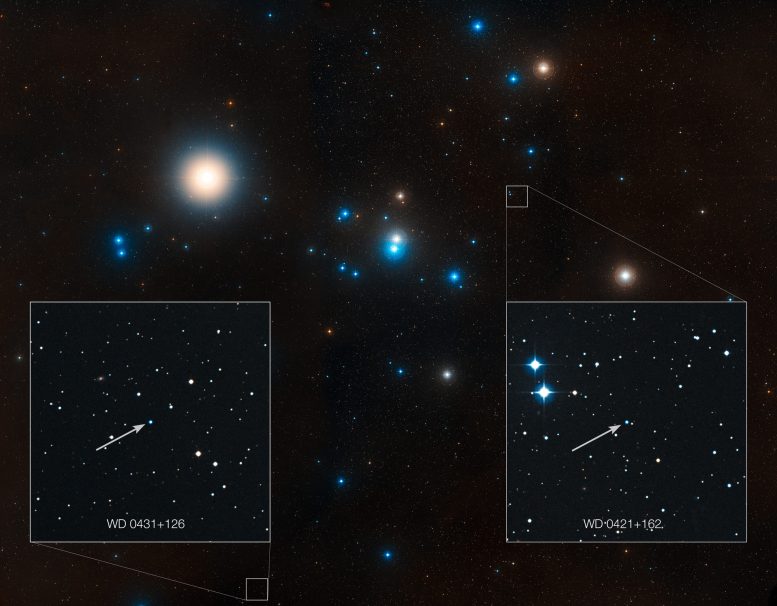
This image shows the region around the Hyades star cluster, the nearest open cluster to us. The Hyades cluster is very well-studied due to its location, but previous searches for planets have produced only one. A new study led by Jay Farihi of the University of Cambridge, UK, has now found the atmospheres of two burnt-out stars in this cluster — known as white dwarfs — to be “polluted” by rocky debris circling the star. Inset, the locations of these white dwarf stars are indicated — stars known as WD 0421+162, and WD 0431+126. Credit: NASA, ESA, STScI, and Z. Levay (STScI)
Besides finding silicon in the Hyades stars’ atmospheres, Hubble also detected low levels of carbon. This is another sign of the rocky nature of the debris, as astronomers know that carbon levels should be very low in rocky, Earth-like material. Finding its faint chemical signature required Hubble’s powerful Cosmic Origins Spectrograph (COS), as carbon’s fingerprints can be detected only in ultraviolet light, which cannot be observed from ground-based telescopes.
“The one thing the white dwarf pollution technique gives us that we won’t get with any other planet detection technique is the chemistry of solid planets,” Farihi says. “Based on the silicon-to-carbon ratio in our study, for example, we can actually say that this material is basically Earth-like.”
This new study suggests that asteroids less than 160 kilometers across[3] were gravitationally torn apart by the white dwarfs’ strong tidal forces, before eventually falling onto the dead stars.[4]
The team plans to analyze more white dwarfs using the same technique to identify not only the rocks’ composition, but also their parent bodies. “The beauty of this technique is that whatever the Universe is doing, we’ll be able to measure it,” Farihi said. “We have been using the Solar System as a kind of map, but we don’t know what the rest of the Universe does. Hopefully with Hubble and its powerful ultraviolet-light spectrograph COS, and with the upcoming ground-based 30- and 40-meter telescopes, we’ll be able to tell more of the story.”
Notes
- The two “polluted” Hyades white dwarfs are part of a search of planetary debris around more than 100 white dwarfs, led by Boris Gänsicke of the University of Warwick, United Kingdom. Using computer models of white dwarf atmospheres, Detlev Koester from the University of Kiel in Germany is determining the abundances of various elements that can be traced to planets in the COS data.
- Seeing evidence of asteroids points to the possibility of Earth-sized planets in the same system. Asteroids are the building blocks of major planets. Planet-forming processes are inefficient, and spawn many times more small bodies than large bodies — but once rocky embryos the size of asteroids are built, planets are sure to follow.
- The team estimated the size of the infalling asteroids by measuring the amount of dust being gobbled up by the stars — about 10 million grams per second, equal to the flow rate of a small river. They then compared that data with measurements of material falling onto other white dwarfs.
- The Hyades study offers insight into what will happen in the Solar System when the Sun burns out, five billion years from now.
Reference: “Evidence of rocky planetesimals orbiting two Hyades stars” by J. Farihi, B. T. Gänsicke and D. Koester, 24 April 2013, Monthly Notices of the Royal Astronomical Society.
DOI: 10.1093/mnras/stt432


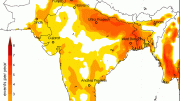


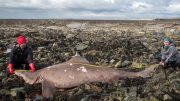
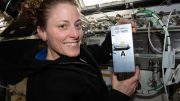
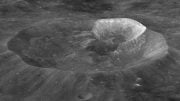

Be the first to comment on "Hubble Finds Planetary Debris Whirling Around Two White Dwarfs"